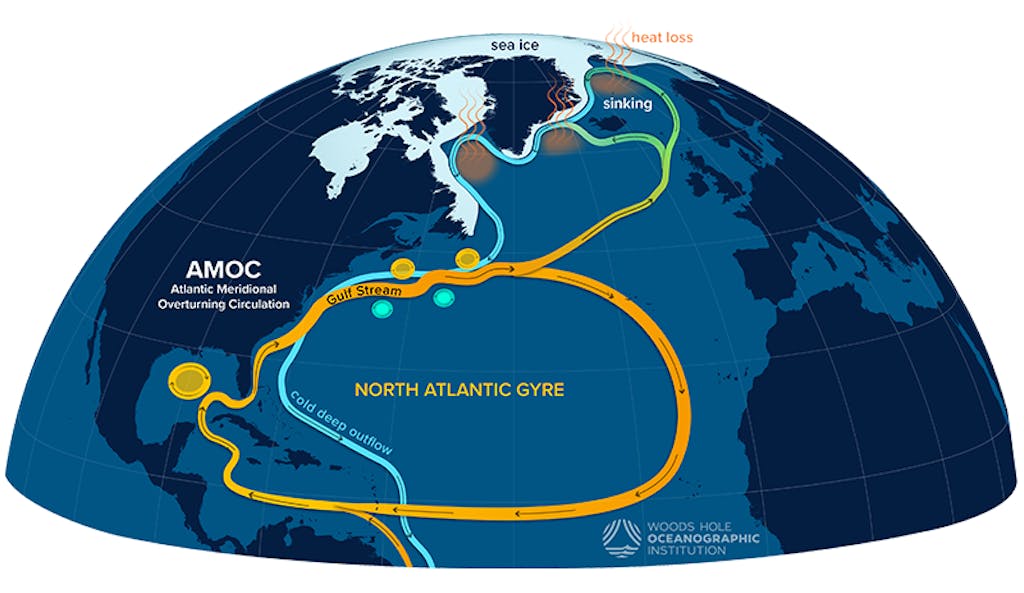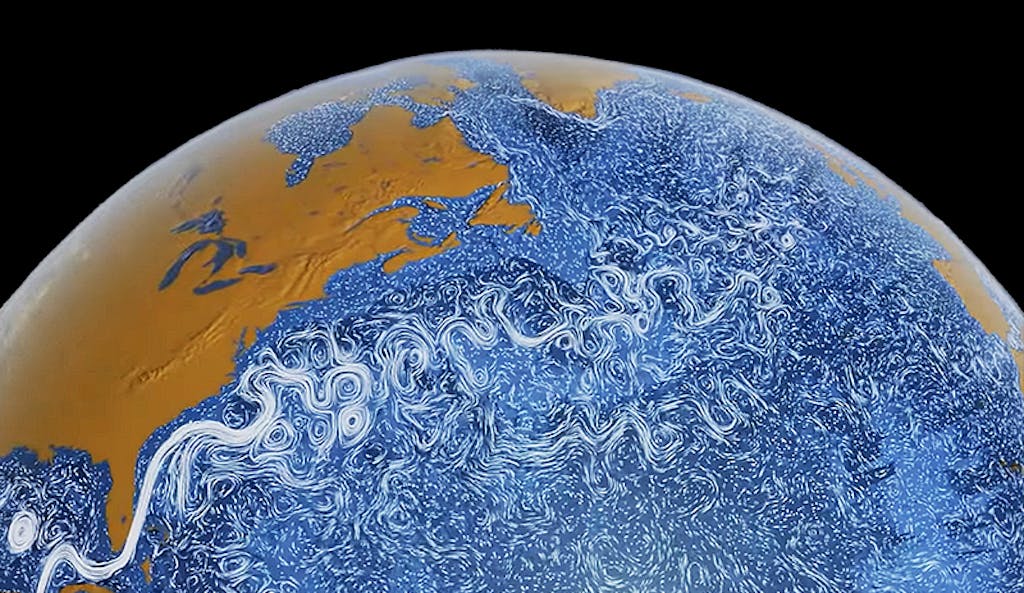FSometimes we struggle to understand how the ocean affects our lives because we see it as a simple, calm body of water. But in reality, it is much larger and more chaotic than we can imagine. Its movements are unique and can't be compared to anything on land.
Right now, in the Atlantic Ocean, a single current called the Gulf Stream is moving more water than all the world’s rivers combined. There are also many large swirling movements across the ocean that we can't see with our eyes.
We are doing large-scale experiments to our global climate system.
The ocean's movements carry a lot of salt, nutrients, oxygen, CO, and heat around the planet. The ocean is crucial for regulating our climate and makes it possible for us to live on Earth.
If a current in the ocean changes, it can affect how heat moves around the planet, which can then change temperatures and rainfall, making places habitable or uninhabitable. Many experts think that human activity might cause a big change in the ocean, which could have a devastating impact on the climate worldwide.
You don’t have to travel back far in Earth’s history to find a moment when the ocean upended the global climate.
About 13,000 years ago, as the planet warmed and the ice sheets began melting, there was a sudden and mysterious cooling. The temperature dropped quickly and significantly in some parts of the world, causing glaciers to grow and changing the climate across the globe. After more than a thousand years, temperatures suddenly returned to normal.

The effects of this event were not isolated to the North Atlantic. Paleo-climate records show a shift in monsoon patterns across the tropics, as well as altered climate patterns in China, South America, Africa, and the western United States. Some archaeologists even note a shift in human lifestyles, marking a return from settled to more nomadic living. More than a millennium would pass before temperatures abruptly returned to their previous highs.
This time in Earth’s history is called the Younger Dryas, which is named after a tough flower that grew in Europe during that period. It is seen as the last major cold period as the world transitioned from the Ice Age to the current geologic epoch, the Holocene. current geologic epoch, the Holocene. While there is some debate about what caused this significant climactic change, many scientists think the culprit was the collapse of the Atlantic Meridional Overturning Circulation (AMOC): a system of currents that move warm water northward at the surface of the Atlantic Ocean and cold water southward in its depths. While the AMOC may seem complex, it is one of the most important systems in Earth’s climate.
IIn the ocean, water is not the same everywhere. Water in the tropics is saltier than water near the poles due to evaporation and rainfall patterns. As tropical water moves northward in the Atlantic, pushed by wind and pulled by differences in ocean density, it loses its heat in high latitudes. As a result, the water not only becomes saltier but also cold and dense. It becomes so dense that it starts to sink and move into the ocean’s deepest layers. From there, the water begins a long journey south, joining a great, globe-spanning loop connecting every region of the ocean.
This loop is called the global thermohaline circulation—thermo meaning heat, haline meaning salt. The global thermohaline circulation is sometimes compared to a conveyor belt, but the comparison only goes so far in a system as unpredictable and shifting as the ocean. Eventually, the once-tropical water resurfaces, although this may take anywhere from 100 to 1,000 years depending on its path. In this simplified sense, we can think of the AMOC as one part of a large system of ocean currents responsible for moving large amounts of salt and heat around the planet.
Is a great oceanic shift upon us? Is a critical ocean system on the verge of collapse?
Along with events like the breakup of the Greenland and West Antarctic ice sheets, boreal forest dieback, and a permanent El Niño in the Pacific, an AMOC shutdown is seen as a tipping point in Earth’s climate system. Tipping points are thresholds that, once crossed, quickly change the balance of the planet. Scientists believe that during the Younger Dryas, the AMOC collapsed after large amounts of freshwater from melting ice sheets flooded into the North Atlantic. The water there became too fresh and light to sink. As a result, the connection between the upper and lower flows of the AMOC was severed or at the very least severely weakened, altering the global thermohaline circulation at large. The way heat moved around the planet had fundamentally changed.
As Earth heats up and melting freshwater from the Greenland Ice Sheet flows into the North Atlantic, many scientists worry that the stage is set for a repeat of the Younger Dryas. By some estimates, the AMOC has slowed by 10 to 15 percent in the past century, leading to concern that the system could be headed for a collapse.
“A substantial weakening or shutdown of AMOC would be catastrophic,” says Jerry McManus, an Earth scientist at Columbia University who studies past changes in climate and ocean circulation. Computational models suggest that Europe could experience temperatures not felt since the last Ice Age, while parts of the southern hemisphere would experience extreme heat. The eastern seaboard of the United States would see a rapid increase in sea level rise, while the monsoon rains, on which much of the world relies, would shift southwards. Mass migration would occur. Agricultural systems would collapse. War and political upheaval would likely follow as people tried to adapt. The very fabric of life would be altered in many parts of the world. “Our society is having a hard time dealing with a small amount of change,” says McManus. “We wouldn’t be able to handle 4 degrees over the course of 10 years.”
Iduring the summer of 2023, siblings Peter and Susanne Ditlevsen from the University of Copenhagen released a study a warning about the upcoming AMOC breakdown. By using sea surface temperature records dating back to the 1870s, they created a new statistical method for simulating the AMOC's strength over time. Their model indicated a probable breakdown around the year 2057, with a 95 percent chance of this occurring before 2095 and a slight chance that it could happen by 2025. In comparison, the Intergovernmental Panel on Climate Change (IPCC) had previously stated that the AMOC would slow down during this century but was not likely to collapse before 2100.
The results were published in the journal Nature Communications and caused a media frenzy. “Gulf Stream could collapse as early as 2025, study suggests,” read one headline that mistakenly equated the AMOC with the more well-known Gulf Stream. (This often occurs; the Gulf Stream, a wind-driven current along the western edge of the mid-Atlantic before curving towards Europe, is a part of the AMOC. The future circulation of the Gulf Stream is indeed a cause for concern, but it only represents one aspect of the larger AMOC system.) “Is a Mega Ocean Current about to Shut Down?” read another. “Scientists detect sign that a crucial ocean current is near collapse.”
Many oceanographers challenged the study’s assertions. Some questioned the extent to which meaningful conclusions could be drawn from sea surface temperatures given that a significant portion of the AMOC's behavior is influenced by salinity and temperature at depth. Others noted that one model hardly represents the scientific consensus. Although scientists generally concurred that the AMOC could cease as a result of global warming, it was extremely challenging to predict when or if this would occur.

“There’s no tipping element on Earth for which we can forecast a tipping time at this point,” says Niklas Boers, an Earth scientist at the Technical University of Munich who specializes in modeling climate tipping points. “Predicting an exact collapse time is nearly impossible.”
The challenges associated with predictability, Boers explains, stem from the intricacies of modeling and the underlying data. Some models, like the one utilized by the Ditlevsens, use proxies such as sea surface temperatures to represent the entire system. Their limitations include uncertainty in long-term historical data. For instance, even though temperature and salinity records go back to the late 19th and early 20th centuries, the early data collection methods were primitive and sparse compared to today's standards.
Other models are based on physics: They aim to digitally recreate the complexity of oceanic and atmospheric physics. Their limitations include computer power. “Even on the best supercomputers, our most advanced climate models can take six months to a year to run,” says Boers. To address these constraints, as well as the ocean’s immense complexity, models may be run at lower resolutions or be simplified. While these models yield crucial insights into ocean dynamics, they are far from being a true “digital twin” of the ocean.
Leading climate models, such as those used for the IPCC reports, indicate that the AMOC will slow down, but few have predicted a complete collapse except in extreme climate scenarios.
On this planet, things can get weird fast.
However, a recent study led by oceanographer René van Westen of Utrecht University made headlines by finding that even a gradual increase in freshwater in the North Atlantic, as expected from melting glaciers and the Greenland ice sheet, could eventually cause a sudden shutdown of the AMOC. The researchers concluded that an AMOC collapse could no longer be considered theoretical under current climate conditions and that the present-day AMOC is on route to tipping. They noted, however, that it remains impossible to know precisely how near or far that threshold is.
Despite the strong evidence from climate models, an AMOC slowdown has not yet been confirmed through direct observations. Scientists have only been continuously measuring the system using ocean-spanning sensor arrays since 2004, providing insight into its dynamics, but it’s too soon to know whether the slowdown they’ve detected is part of AMOC’s natural variability or a long-term trend.
Oceans are non-linear and chaotic systems, and small changes can cause large effects. Understanding the mechanisms and threshold for an AMOC tipping point involves considering numerous factors such as CO2, freshwater forcing, relative density, vertical mixing, net evaporation, wind patterns, pressure gradients, bathymetry, atmospheric forcing, and Greenland Ice Sheet stability. The interactions among these factors make the threshold for AMOC’s collapse unclear and ever-shifting. Better models and richer datasets may provide more clarity in the future, but for now, the future can only be seen in low resolution.There have been false alarms in the past, such as a sharp slowdown in the AMOC observed in the early 2000s that was not predicted by scientific models. Some scientists feared an AMOC tipping point was imminent, but the circulation rebounded.
IAfter the Ditlevsen and van Westen studies, scientists faced the challenge of conveying uncertainty without downplaying severity and making sure not to leave space for climate deniers. The question was whether to emphasize the risks or consider the small and distant probabilities.
“Uncertainty is a very tough topic in this field to convey,” says Nick Foukal, a physical oceanographer at Woods Hole Oceanographic Institution. When the stakes of an AMOC collapse are so high, it becomes hard not to sound the alarm. Existential risk changes the communications calculus, as a small chance of climate upheaval and ecological collapse is very different from a small chance of a paper cut.
It might not be as bad as some fear. It may be worse than we can imagine.
But Foukal warned that there are still many unknowns to be discovered about the AMOC. In the past, it seems to have switched between strong and weak states, and it may also have in-between states as well. As sea ice melts, crucial overturning locations could move to saltier or colder areas of the ocean where the water is still dense enough to sink. Maybe these patterns change some ocean dynamics, but not in a devastating way. Foukal says there is good evidence to suggest that the AMOC may be more resilient than we think.
Even if the future of the AMOC is more complex than the headlines indicate, none of the potential outcomes are something humanity should want to experience, according to Kjetil Våge, an oceanographer at the University of Bergen. He says, 'All these scenarios are essentially undesirable scenarios.' We are conducting large-scale experiments on our global climate system, and we do not understand how these experiments will unfold.
Waiting for a definitive Waiting for a definite answer about the AMOC’s future is similar to waiting for a doctor’s test results. We know we’re sick, but is it fatal? Are we doomed or is there something we can do?
In an ideal world, our models and observations would cover the full complexity of the AMOC. We would know the exact limitations of the system and exactly how to safely live within those boundaries. However, for now, many scientists suggest it is best to be cautious. Boers says, 'Not being able to predict a tipping point does not mean there is less urgency in trying to prevent or reduce the likelihood of a tipping point. Until we can rule out the possibility of such a tipping point, the greater the uncertainties, the more we should stay away from greenhouse gas and temperature thresholds.'
It is clear that an abrupt climate shift is too risky to bet against, and changes to the AMOC can lead to rapid and catastrophic changes in climate patterns worldwide.
As we continue to release greenhouse gases into the atmosphere, we are not only hoping to avoid the worst effects of rising temperatures, changing weather patterns, and sea level rise, but also gambling that the scientific principles underlying our lives remain stable enough for adaptation to remain possible. But things can become unpredictable quickly on this planet. Beyond a certain point, conditions may not be conducive to our survival. We may not be playing dice like God, but we are taking risks as we continue to engage in a high-stakes climate game with incomplete information.
Recent studies indicate that the Gulf Stream current is slowing, sea ice is at record lows, and ocean temperature records are being broken. In the North Atlantic, some scientists see a region of mysterious cooling as further evidence of the shifting dynamics of the AMOC. Change is on the way, and each new discovery is like the rumble signaling a train’s approach. Something is stirring in the ocean, but its future state is yet to be seen. It might not be as bad as some fear, or it could be worse than we can imagine.
Maybe we can avoid the worst. The future is like an ocean, vast and chaotic, and influenced by a complex set of factors including us and our decisions.
Lead picture: Lightspring / Shutterstock



